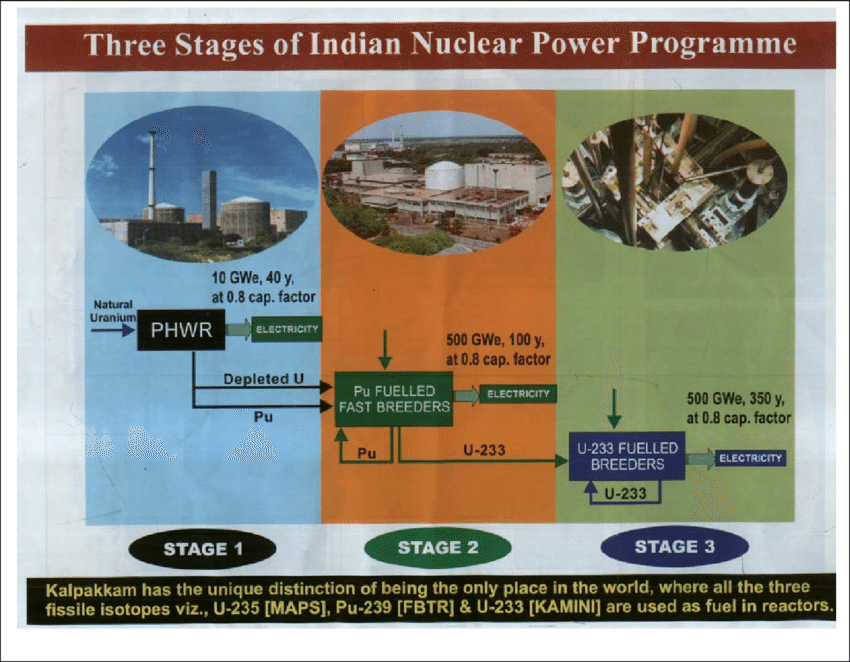- PM Modi presided over the start of core-loading at the indigenous Prototype Fast Breeder Reactor (PFBR) in Kalpakkam, Tamil Nadu, marking a watershed milestone in India’s nuclear energy history.
- This ceremony represents a big step forward in India’s ambitious nuclear power programme, signalling the start of stage II.
Why are we discussing this?
- As of 2024, nuclear power accounts for around 3.11% of India’s total electricity generation.
- Nuclear power remains India’s fifth-largest source of electricity, after coal, gas, hydroelectricity, and wind power.
About India’s 3-stage Nuclear Power Program
| Description | Timeline | |
| Stage 1 | Relies on pressurized heavy water reactors (PHWRs) using natural uranium as fuel. | Initiated in the 1950s;Operational since the 1960s |
| Stage 2 | Focuses on developing fast breeder reactors (FBRs) using plutonium-239 produced in Stage 1. | Initiated in the 1970s;Development phase |
| Stage 3 | Involves the development of thorium-based reactors utilizing India’s significant thorium reserves. | Initiated in the late 1980s/early 1990s;Research & Development phase |
What is Prototype Fast Breeder Reactor (PFBR)?
- Energy generation: The PFBR is a fast breeder reactor that produces more nuclear fuel than it uses, allowing for long-term energy generation.
- Operationalization Milestone: The start of core-loading is critical since it marks the second step of India’s three-stage nuclear power programme, which aims to achieve nuclear energy self-sufficiency.
- Technical specifications: The PFBR, which is designed to use plutonium-239 (Pu-239) in conjunction with uranium-238 (U-238), is a significant step forward in Indian nuclear technology.
Technical insights into PFBR operations.
- Core Functionality: Unlike pressurised heavy water reactors (PHWRs), which use natural uranium, the PFBR uses Pu-239 and U-238 to generate energy.
- Cooling Mechanism: The primary coolant is liquid sodium, which facilitates heat transfer and power generation via secondary circuits.
Challenges and Delays.
- Historical Aspect: The PFBR project experienced significant delays and cost overruns due to technical complications and logistical challenges.
- Sanctions Impact: Sanctions imposed on India following the ‘Smiling Buddha’ nuclear test in 1974 hampered the project, forcing changes in fuel type and operational factors.
- Human Resource Constraints: The retirement of experienced project professionals, combined with decision-making delays, contributed to project difficulties.
- Financial Implications: The project’s escalating expenditures, estimated to reach ₹6,800 crore by 2019, highlight financial and administrative challenges.
- Procurement Challenges: Audit investigations found procurement inefficiencies, with average delays of 158 days per order, worsening project deadlines and costs.
Future Perspectives and Technological Innovations
- The role of small modular reactors (SMRs): SMRs appear as a viable alternative, providing improved safety features and operating flexibility, albeit with regulatory changes.
- Stage II Expansion: The PFBR’s 500 MWe capacity paves the way for future FBR developments that match with India’s energy diversification and decarbonisation objectives.
- Regulatory imperatives: Addressing concerns about safety and regulatory monitoring is critical to maintaining public trust and operational integrity.
Conclusion
- As India navigates the hurdles of nuclear power development, the PFBR demonstrates scientific prowess and strategic insight.
- While problems remain, the trajectory of stage II demonstrates India’s commitment to using nuclear energy for sustainable development and energy security.
- With continuous innovation and regulatory change, India is on track to realise its ambition of a strong and self-sufficient nuclear energy sector.
Source: https://world-nuclear.org/information-library/country-profiles/countries-g-n/india.aspx#:~:text=for%202012%2D17.-,The%20total%20nuclear%20capacity%20is%20likely%20to%20be%20about%2022.5,of%20India's%20electricity%20by%202047.

